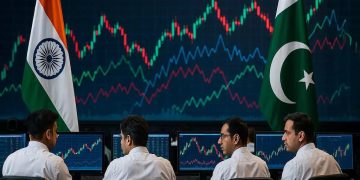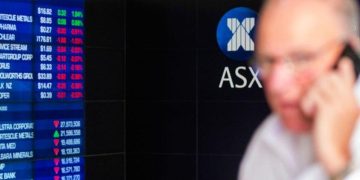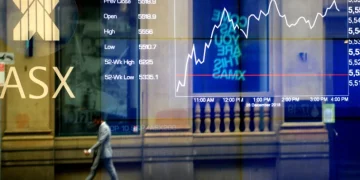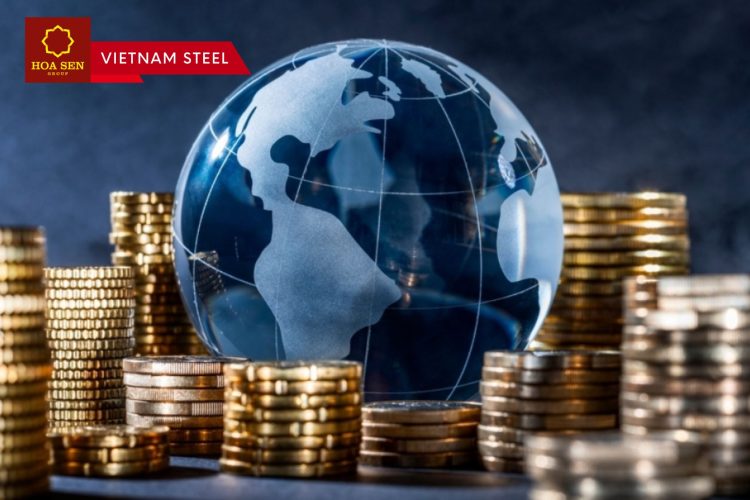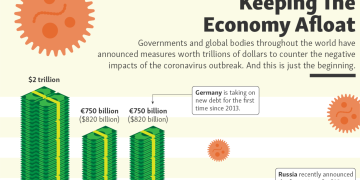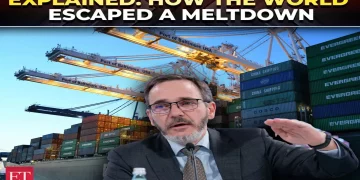1. The Era of Fragile Certainty
The global economy is entering a new age of fragility — one defined not by crisis alone, but by the persistent shadow of uncertainty. After years of pandemic disruption, inflation surges, and energy shocks, nations are now grappling with a quieter but more insidious threat: the instability of policy itself.
In 2025, the International Monetary Fund (IMF) projects global GDP growth to slow to 3.2%, with further moderation expected in 2026. The Organisation for Economic Co-operation and Development (OECD) paints an even gloomier picture, forecasting growth closer to 2.9% next year. Beneath these numbers lies a deeper concern: governments are struggling to maintain credibility in the face of rising debt burdens, populist pressures, and geopolitical volatility.
From Washington to Brussels to Beijing, policymakers face a delicate balancing act — stimulating sluggish economies without reigniting inflation, tightening fiscal discipline without stifling investment, and maintaining global cooperation while domestic politics turn inward. The result, as one IMF analyst recently noted, is “a world where policy is reactive, not strategic.”
2. Debt at Record Highs
The most pressing symptom of this instability is debt.
According to the IMF’s Global Debt Monitor, total global debt — public and private combined — reached $315 trillion in 2024, equivalent to more than 330% of global GDP. Government borrowing surged during the pandemic to fund relief packages and infrastructure spending, but instead of stabilizing afterward, debt levels have remained stubbornly high.
The United States’ federal debt now exceeds $34 trillion, or roughly 120% of GDP, surpassing levels seen after World War II. In the European Union, countries like Italy and France face debt ratios above 110%, even as the European Central Bank (ECB) warns of tighter lending conditions. Meanwhile, emerging economies — from Argentina to Pakistan — are struggling with currency depreciation and soaring borrowing costs, as global interest rates remain elevated.
The World Bank estimates that nearly 60% of low-income countries are now in or near debt distress. That figure is double what it was a decade ago.
This accumulation of debt has created what economists call “policy inertia.” Governments simply have less fiscal room to maneuver. Every percentage point increase in interest rates now translates into billions in additional debt-servicing costs, crowding out spending on education, healthcare, and green transition initiatives. As IMF Managing Director Kristalina Georgieva warned in a recent speech, “Fiscal fragility is becoming a global contagion — and confidence is the first casualty.”
3. The Policy Tightrope
Policymakers today must navigate a paradox: inflation has cooled, but not vanished; growth has slowed, but not collapsed. Central banks, particularly the U.S. Federal Reserve and the ECB, remain wary of cutting rates too quickly for fear of reigniting price pressures. Yet the longer rates remain high, the greater the strain on households, businesses, and government budgets alike.
In the United States, fiscal policy has become a battleground.
The political polarization surrounding spending priorities — from defense budgets to social welfare — has made long-term planning nearly impossible. Temporary budget resolutions have become routine, with repeated showdowns over debt ceilings and government shutdown threats.
In Europe, fiscal rules are back in focus. The EU’s Stability and Growth Pact, suspended during the pandemic, is being reintroduced with stricter oversight, demanding that member states curb deficits below 3% of GDP. But enforcing austerity amid social unrest and weak growth poses both economic and political risks.
China faces a different challenge. Its debt problem lies not in the central government but in local financing vehicles — opaque entities that borrowed heavily to fund construction and industrial projects. As property markets falter and export growth weakens, Beijing must choose between deleveraging and stimulus. Each option carries long-term consequences for financial stability.
In short, the world’s major economies are walking a policy tightrope, where every adjustment risks upsetting a fragile equilibrium.
4. The Cost of Uncertainty
Beyond the numbers, policy instability erodes something more intangible — confidence.
For investors, uncertainty about future tax policies, interest rates, or regulatory regimes translates into hesitation. Global foreign direct investment (FDI) flows have dropped nearly 20% since 2021, according to UNCTAD, reflecting a world where strategic patience outweighs ambition.
For consumers, unpredictable fiscal policies affect expectations about inflation, wages, and job security, dampening spending and prolonging economic sluggishness.
Corporations, too, are retreating to defensive strategies. Multinationals are holding record levels of cash, wary of overcommitting in volatile markets. Many are diversifying supply chains — not for efficiency, but for resilience — relocating production closer to home or within “friendly” trade blocs.
Economists call this environment “policy risk premia.”
When uncertainty becomes systemic, investors demand higher returns to offset the unpredictability — raising the cost of capital and further slowing growth. It’s a self-reinforcing cycle: instability breeds caution, which in turn amplifies instability.

5. Political Cycles, Economic Consequences
Another major driver of policy volatility is politics itself.
In 2024–2025, more than 70 countries, representing over half of global GDP, are holding elections. Populist rhetoric, fiscal promises, and shifting trade stances have injected volatility into markets. Governments that face short election cycles often prioritize short-term stimulus over structural reform, deferring difficult decisions until after the ballot box closes.
This cycle creates what analysts at McKinsey call “fiscal fatigue.”
Voters expect governments to cushion every downturn, subsidize every cost increase, and shield them from global shocks. Yet these measures — tax cuts, subsidies, cash transfers — all expand deficits. The resulting fiscal hangover forces painful retrenchments later, often when growth is weakest.
Emerging democracies face an even sharper dilemma.
Countries like Turkey, Brazil, and Indonesia have struggled to maintain investor confidence amid shifting political priorities and inconsistent monetary policies. In some cases, attempts to cap inflation through price controls or currency interventions have backfired, leading to capital flight and currency depreciation.
The IMF warns that such cycles risk creating a “credibility trap” — where markets doubt government commitments, forcing higher borrowing costs and deepening fiscal distress. Breaking that cycle requires transparency, consistent policymaking, and, above all, trust — qualities in short supply in a polarized world.
6. The Shadow of the Next Crisis
The global debt problem is not just a fiscal issue; it’s a systemic one.
A high-debt world is more vulnerable to shocks. Even modest disruptions — a rise in oil prices, a trade dispute, or a geopolitical flare-up — can trigger liquidity strains that ripple through financial systems. The 2022–2023 turmoil in British bond markets and the 2024 debt crisis in several African economies are reminders of how quickly confidence can evaporate.
Financial institutions are also on edge. As interest rates remain high, defaults among corporate borrowers are rising. According to S&P Global, the global default rate for speculative-grade debt reached 4.5% in mid-2025, the highest since the pandemic.
Banks are tightening lending standards, while shadow-banking activities — including private credit and fintech-driven lending — are expanding beyond regulatory oversight.
Meanwhile, global coordination is weakening.
The G20 debt restructuring framework, designed to help low-income nations renegotiate their obligations, has stalled amid disagreements between China and Western creditors. Without cooperation, debt relief efforts risk fragmentation — a dangerous scenario if multiple countries face simultaneous crises.
7. Searching for Stability
Despite the gloom, there are signs of adaptation.
Several advanced economies are pursuing “fiscal anchor” policies — medium-term budget frameworks that cap spending and debt levels while allowing flexibility in downturns.
Japan, despite its enormous public debt, continues to demonstrate the benefits of long-term domestic financing and stable central-bank coordination.
In Europe, new green bonds are being used not only to fund energy transitions but also to discipline spending around measurable outcomes.
The IMF and World Bank are also advocating for better debt transparency and predictable restructuring mechanisms, to prevent crises from cascading. Digital finance tools, from blockchain-based sovereign bonds to AI-driven fiscal forecasting, may enhance accountability and efficiency in the next decade.
However, real stability will depend on rebuilding public trust.
Economic credibility is not just about numbers — it’s about confidence that governments will act responsibly, that policies will not swing wildly with each election, and that long-term challenges like climate transition and inequality will not be sacrificed to short-term politics.
8. The Decade Ahead
The story of the next decade will be written not by how much debt nations hold, but by how they manage it.
The debt itself is not inherently dangerous; it’s the uncertainty surrounding its sustainability that poses the greatest risk. As the IMF puts it, “Predictability is the new stability.” In a world awash with debt and distrust, credibility may become the most valuable currency of all.
If the 2010s were defined by growth without inflation, and the early 2020s by inflation without growth, then the mid-2020s may be remembered as the era of instability without crisis — a period where economies drift rather than collapse, restrained not by recession but by hesitation.
To break free from that inertia, policymakers must rediscover the art of long-term thinking — and the courage to act before the next shock arrives.








